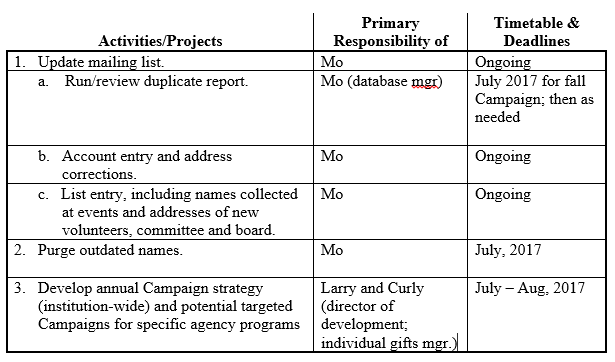
What key items belong on a fundraising menu?
A good fundraising strategic plan, like a menu, should be broken into component parts so it’s easy to wrap your brain around.
With a menu, it might be appetizers, meat entrees, seafood entrees, vegetarian entrees, sides and desserts.
With a fundraising plan, it tends to break down into strategies.
It might be annual giving, major gifts, legacy gifts, foundation grants, business sponsors, events and so forth.
Before you can get to determining your priority strategies, however, you need to do a mini fundraising audit.
When I begin working with a new nonprofit client, I always ask the same three questions.
3 Fundamental Questions to Answer Before Building Your Fundraising Plan:
1. What’s your mission and why should I support you?
In other words, do you know what’s unique about what you do and what would compel others to join you?
And is everyone in your organization on the same page?
You would be amazed how often there is significant disagreement on this point. It’s like opening a restaurant where a third of the folks think you’re serving Mexican, another third think Italian, and another third think burgers and fries. That’s a hard sell.
How much do you need to raise, and why?
Be clear about your specific purposes, and what additional revenue will enable you to accomplish.
Without clarity on your mission and case for support, messaging to support effective fundraising is extremely difficult to come by.
Again, it’s like trying to run a restaurant without deciding on your market niche and how you’re distinct from your competition.
2. What’s currently in your pantry?
In other words, what ingredients do you have to work with? This breaks down into things like:
- How many donors do you have?
- How many are new vs. ongoing?
- What are your donor and donation retention rates?
- How big is your mailing list? Email list?
- How much money did you raise last year, and the year before that?
- How did your contribution income break down (e.g., individual gifts, major individual gifts, foundation grants, business sponsorships, and government grants or contracts)?
- What does your marketing communications plan look like?
- What communications tools do you have at your disposal (e.g., website, social media, database, CRM, email service provider, etc.)
3. What’s the internal support for philanthropy?
In other words, is the fundraising function relegated to a single development staffer or a single board committee? Or is fundraising part of everyone’s job. To get at this, I’ll ask questions like:
- Does everyone on your board give?
- Does everyone on your board participate in fundraising?
- Do staff give?
- Do non-development staff participate in fundraising as either ambassadors, advocates or askers?
- Are fundraising and marketing functions integrated?
- Do development staff attend board meetings?
- Do program staff ever attend development staff meetings, and vice-versa?
- Is development on the agenda of every board meeting?
- Do development staff participate in strategic planning?
Based on the answers to all these questions, you’ll be able to begin to put together a realistic plan/menu.
If you don’t have certain ingredients, it’s best not to put items requiring those ingredients on your menu until you secure them.
But this doesn’t mean you can’t begin somewhere.
Where to Begin
Begin with your mission.
Fundraising supports your mission. Plain and simple. Your mission is fundraising’s raison d’etre.
Once your overall strategic plan is built and a budget is created, how much of that budget must come from fundraising?
That’s your overarching goal. The why of your fundraising plan.
What goes into your plan?
Everyone knows the basic ‘sections’ of a dinner menu. Similarly, most nonprofits know the basic elements of a comprehensive fundraising plan.
It’s a good place to get started.
Here’s how I built my fundraising plans/menus:
I did this over 30 years, working for five different organizations as a director of development and marketing.
I broke my plans into these strategic areas:
- Annual Giving
- Major Gifts
- Legacy Gifts
- Special Events
- Grants
- Business Sponsors
- Marketing Communications
- Public Relations
- Infrastructure and database
Every strategy is supported by specific, measurable objectives. (e.g. renew 75% of major donors; renew 50% of ongoing donors under $1,000; renew 40% of new donors).
Every objective is supported by specific tactics with assigned timeframes and executors (e.g., complete in June/July; by director of development, individual giving manager and database manager).
Here’s a snippet of a plan under the “Annual Giving” area, just to give you an idea of how this might look:
 You can also see an example of a timely Annual Appeal Fundraising Timeline You Can Use right now which I have published on the Bloomerang blog.
You can also see an example of a timely Annual Appeal Fundraising Timeline You Can Use right now which I have published on the Bloomerang blog.
Walk before you run
Today, when I work with a nonprofit without much of a fundraising track record, I might suggest excluding some of these areas until pre-conditions are in place.
For example, if your organization is less than ten years old and has very few donors, you might not be ready to build a legacy giving program. Similarly, if your cause is faith-based your opportunities to build business support might be limited. And so forth.
I would also likely break these categories down even further.
Fir example, ‘annual giving’ might comprise acquisition, retention and upgrade strategies; ‘marketing communications’ might comprise website; print materials, and digital content.
However you build your plan, you’ll want to include other key stakeholders.
Use planning as an opportunity to review and evaluate past results, educate others about best practices, examine your infrastructure and activate commitment.
Don’t Build Too Big of a Menu
When you over commit you under perform.
Realistically assess your available resources and past results.
I know it’s really hard to do this (I fail at this all the time). But try.
Build your plan based on the realities of your situation now.
Establish some key initiatives and dollar goals, and go after them aggressively. Once you’re successful, you can build on that success.
Summary:
- Clearly state your organization’s shared vision, mission and values.
- Assess where you are now in terms of fundraising results by looking at your data.
- List your current strategies.
- Consider additional strategies you want to add.
- Evaluate your greatest challenges.
- Consider you best opportunities
- Involve all key stakeholders
- Set realistic goals based on available resources and past results
You may also want to check out the precursor to this article: Master Chef vs. Line Cook: How Do You Prepare Your Nonprofit Fundraising Plan?
I won’t blame you if you’re starting to get a bit hungry.
REMINDER:
 Grab the 7 Clairification Keys to Unlock Your Nonprofit’s Fundraising Potential if you want to delve deeper into developing the necessary mindset, and supporting infrastructure, to show donor-investors what’s in it for them to affiliate with you. This 42-page guide includes 12 easy-to-use worksheets and exercises to help you bring your best intentions and good ideas to life!
Grab the 7 Clairification Keys to Unlock Your Nonprofit’s Fundraising Potential if you want to delve deeper into developing the necessary mindset, and supporting infrastructure, to show donor-investors what’s in it for them to affiliate with you. This 42-page guide includes 12 easy-to-use worksheets and exercises to help you bring your best intentions and good ideas to life!
And should you ever wish to bat any ideas around with me, I’m available for up to four discounted Hours of Power. Please check this out if you think I can be helpful to you.
And don’t hesitate to ask if you have questions.
Email me at Claire@clairification.com.





